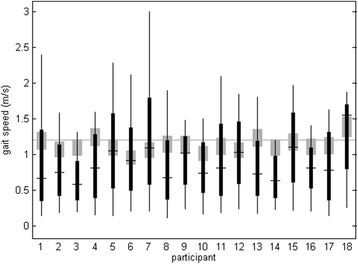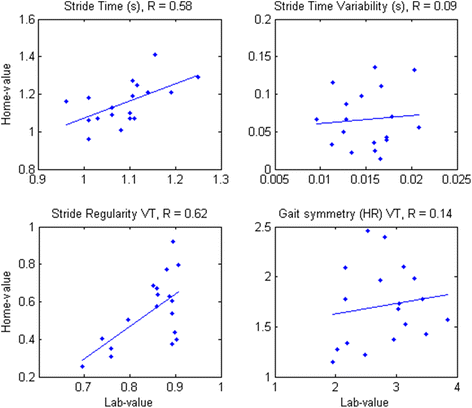Fall-related gait characteristics on the treadmill and in daily life
- PMID: 26837304
- PMCID: PMC4736650
- DOI: 10.1186/s12984-016-0118-9
Fall-related gait characteristics on the treadmill and in daily life
Abstract
Background: Body-worn sensors allow assessment of gait characteristics that are predictive of fall risk, both when measured during treadmill walking and in daily life. The present study aimed to assess differences as well as associations between fall-related gait characteristics measured on a treadmill and in daily life.
Methods: In a cross-sectional study, trunk accelerations of 18 older adults (72.3 ± 4.5 years) were recorded during walking on a treadmill (Dynaport Hybrid sensor) and during daily life (Dynaport MoveMonitor). A comprehensive set of 32 fall-risk-related gait characteristics was estimated and compared between both settings.
Results: For 25 gait characteristics, a systematic difference between treadmill and daily-life measurements was found. Gait was more variable, less symmetric, and less stable during daily life. Fourteen characteristics showed a significant correlation between treadmill and daily-life measurements, including stride time and regularity (0.48 < r < 0.73; p < 0.022). No correlation between treadmill and daily-life measurements was found for stride-time variability, acceleration range and sample entropy in vertical and mediolateral direction, gait symmetry in vertical direction, and stability estimated as the local divergence exponent by Rosenstein's method in mediolateral direction (r < 0.16; p > 0.25).
Conclusions: Gait characteristics revealed less stable, less symmetric, and more variable gait during daily life than on a treadmill, yet about half of the characteristics were significantly correlated between conditions. These results suggest that daily-life gait analysis is sensitive to static personal factors (i.e., physical and cognitive capacity) as well as dynamic situational factors (i.e., behavior and environment), which may both represent determinants of fall risk.
Figures


Similar articles
-
The effect of walking speed on quality of gait in older adults.Gait Posture. 2018 Sep;65:112-116. doi: 10.1016/j.gaitpost.2018.07.004. Epub 2018 Jul 10. Gait Posture. 2018. PMID: 30558916
-
Identification of fall risk predictors in daily life measurements: gait characteristics' reliability and association with self-reported fall history.Neurorehabil Neural Repair. 2015 Jan;29(1):54-61. doi: 10.1177/1545968314532031. Epub 2014 Apr 23. Neurorehabil Neural Repair. 2015. PMID: 24759809
-
Daily-Life Gait Quality as Predictor of Falls in Older People: A 1-Year Prospective Cohort Study.PLoS One. 2016 Jul 7;11(7):e0158623. doi: 10.1371/journal.pone.0158623. eCollection 2016. PLoS One. 2016. PMID: 27389583 Free PMC article.
-
Ecological Gait as a Fall Indicator in Older Adults: A Systematic Review.Gerontologist. 2020 Jul 15;60(5):e395-e412. doi: 10.1093/geront/gnz113. Gerontologist. 2020. PMID: 31504484
-
Nonlinear Dynamic Measures of Walking in Healthy Older Adults: A Systematic Scoping Review.Sensors (Basel). 2022 Jun 10;22(12):4408. doi: 10.3390/s22124408. Sensors (Basel). 2022. PMID: 35746188 Free PMC article.
Cited by
-
Feasibility of a Mobile-Based System for Unsupervised Monitoring in Parkinson's Disease.Sensors (Basel). 2021 Jul 21;21(15):4972. doi: 10.3390/s21154972. Sensors (Basel). 2021. PMID: 34372208 Free PMC article.
-
Quality of Daily-Life Gait: Novel Outcome for Trials that Focus on Balance, Mobility, and Falls.Sensors (Basel). 2019 Oct 11;19(20):4388. doi: 10.3390/s19204388. Sensors (Basel). 2019. PMID: 31614440 Free PMC article.
-
Kinematic and Clinical Outcomes to Evaluate the Efficacy of a Multidisciplinary Intervention on Functional Mobility in Parkinson's Disease.Front Neurol. 2021 Mar 23;12:637620. doi: 10.3389/fneur.2021.637620. eCollection 2021. Front Neurol. 2021. PMID: 33833729 Free PMC article.
-
An Automatic Gait Feature Extraction Method for Identifying Gait Asymmetry Using Wearable Sensors.Sensors (Basel). 2018 Feb 24;18(2):676. doi: 10.3390/s18020676. Sensors (Basel). 2018. PMID: 29495299 Free PMC article.
-
Cross-sectional analysis of speed-up mechanism in normal gait among healthy older adults with and without falls - Results from the Baltimore Longitudinal Study of Aging.Gait Posture. 2025 Jan;115:82-85. doi: 10.1016/j.gaitpost.2024.11.004. Epub 2024 Nov 13. Gait Posture. 2025. PMID: 39566360
References
-
- Weiss A, Brozgol M, Dorfman M, Herman T, Shema S, Giladi N, et al. Does the evaluation of gait quality during daily life provide insight into fall risk? A novel approach using 3-day accelerometer recordings. Neurorehabil Neural Repair. 2013;27(8):742–752. doi: 10.1177/1545968313491004. - DOI - PubMed
-
- Rispens SM, van Schooten KS, Pijnappels M, Daffertshofer A, Beek PJ, van Dieën JH. Identification of fall risk predictors in daily life measurements: gait characteristics’ reliability and association with self-reported fall history. Neurorehabil Neural Repair. 2015;29(1):54–61. doi: 10.1177/1545968314532031. - DOI - PubMed
Publication types
MeSH terms
LinkOut - more resources
Full Text Sources
Other Literature Sources
Medical

